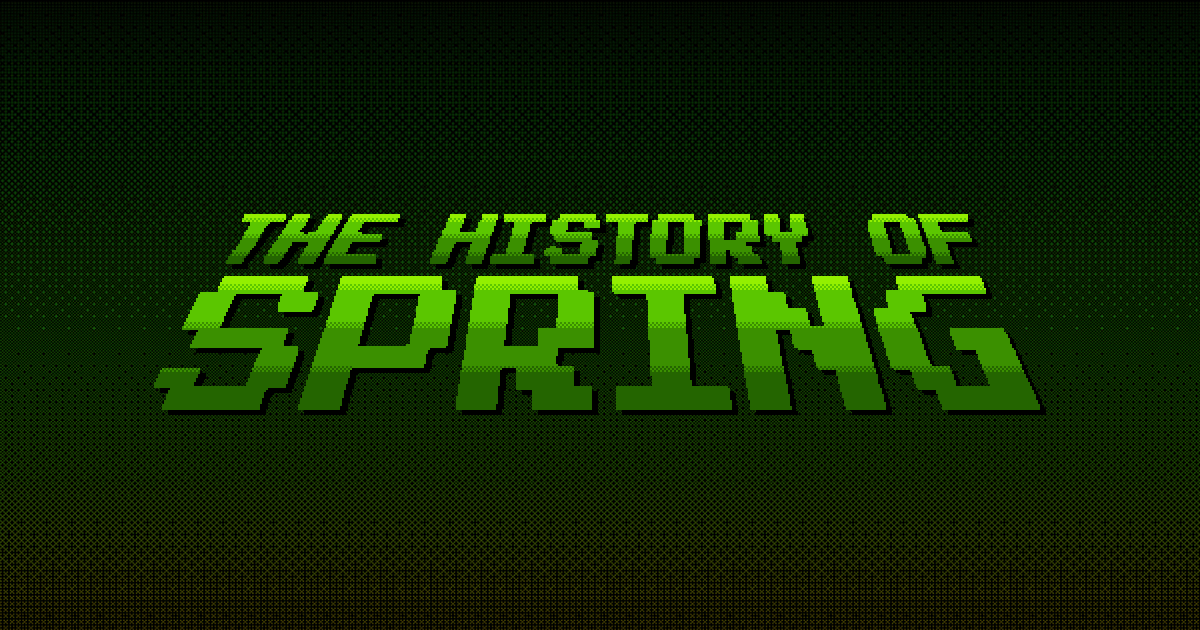[번역] Spring의 역사 (history of spring)
Linkedin 을 보다가 재밌는 링크를 발견해서 정리해본다.
스프링의 역사를 게임처럼 알아볼 수 있는 사이트 https://springone.io/history-of-spring
오픈소스면 한글판을 만들어보고 싶었는데 레포지토리가 따로 보이지 않는 것 같다.
번역
- 2002: Rod Johnson이 J2EE 복잡성을 다루는 책을 출판
- 2003: Rod Johnson, Juergen Hoeller, Yann Caroff가 Spring Framework 오픈 소스 프로젝트를 시작
- 2004: Spring Framework 1.0 출시
- 2008: Spring Security 2.0 출시, Acegi에서 이름 변경
- 2011: Spring Data가 Spring Data MongoDB, Spring Data Redis, Spring Data Neo4j, Spring Data GemFire로 NoSQL 워크로드를 처리
- 2014: Spring Boot 1.0 출시, 애플리케이션을 빠르게 개발할 수 있는 도구 제공
- 2014: Spring Batch 3.0 출시, Spring Boot 동적 부트스트래핑 제공
- 2014: Spring Integration 4.0 출시, XML 없이 통합 흐름을 구성 제공
- 2015: Spring Cloud 1.0 출시, 분산 시스템을 빠르게 개발할 수 있는 소프트웨어 도구 제공
- 2016: Spring Cloud Task 도입, 단기 실행(short-lived) 마이크로서비스 지원
- 2016: Spring Cloud Stream 1.0 출시, 이벤트 기반 마이크로서비스 활성화
- 2016: Spring Cloud Data Flow 1.0 출시, 데이터 마이크로서비스에 대한 오케스트레이션 서비스 제공
- 2016: Spring Cloud Data Flow for Kubernetes 1.0 출시, Kubernetes에서 장기 실행(스트리밍) 및 단기 실행(태스크/배치) 데이터 마이크로서비스에 대한 오케스트레이션 기능 지원
- 2018: Spring Cloud Skipper 1.0 출시, 여러 클라우드 플랫폼에서 애플리케이션 발견 및 생애 주기 관리 제공
- 2021: Spring Cloud Gateway for Kubernetes 출시, YAML 구성 객체를 Kubernetes 클러스터에 적용하여 API 게이트웨이 서비스의 배포를 자동화 지원
- 2022: Spring Boot 3 및 Spring Framework 6 출시, GraalVM을 통해 Kubernetes와 같은 환경에서 네이티브 컴파일된 애플리케이션이 더 효율적으로 실행될 수 있도록 지원
추가 설명
Rod Jonson
“Expert One-on-One J2EE Design and Development” 라는 책을 작성했다고 한다.
long-lived microservice, short-lived microservice
참고 : https://dataflow.spring.io/docs/concepts/architecture/#application-types
장기 실행 어플리케이션(long-lived application)
장기 실행 애플리케이션은 메시지 중심 애플리케이션이 속합니다. 데이터의 양이 정해져 있지 않습니다.
장기 실행 애플리케이션에는 두 가지 유형이 있습니다:
- 단일 입력 과 출력 메시지 기반 애플리케이션
- 여러 입력 과 출력 메시지 기반 애플리케이션
단기 실행 어플리케이션(short-lived application)
단기 실행 어플리케이션은 유한한 데이터 집합을 처리한 후 어플리케이션을 종료합니다.
단기 실행 애플리케이션에는 두 가지 유형이 있습니다.
- Task : 코드를 수행하고 데이터 흐름 데이터베이스에 실행 상태를 기록합니다.
- Batch : 배치 처리를 수행합니다.
원문
- 2002: Rod Johnson publishes book addressing J2EE complexities
- 2003: Rod Johnson, Juergen Hoeller, and Yann Caroff start the Spring Framework open source project
- 2004: Spring Framework 1.0 is released
- 2008: Spring Security 2.0 is released, renaming it from Acegi
- 2011: Spring Data takes on NoSQL workloads with Spring Data MongoDB, Spring Data Redis, Spring Data Neo4j, and Spring Data GemFire
- 2014: Spring Boot 1.0 is released, introducing rapid application development
- 2014: Spring Batch 3.0 released, switching to Spring Boot’s dynamic bootstrapping capabilities over archetypes
- 2014: Spring Integration 4.0 enables integration flows to be configured without XML
- 2015: Spring Cloud 1.0 is released, providing tools to quickly build software for distributed systems
- 2016: Spring Cloud Task is introduced, supporting short-lived microservices
- 2016: Spring Cloud Stream 1.0 is released, enabling event-driven microservices
- 2016: Spring Cloud Data Flow 1.0 is released, providing an orchestration service for data microservices
- 2016: Spring Cloud Data Flow for Kubernetes 1.0 orchestrates long-running (streaming) and short-lived (task/batch) data microservices on Kubernetes
- 2018: Spring Cloud Skipper 1.0 allows app discovery and lifecycle management on multiple cloud platforms
- 2021: Spring Cloud Gateway for Kubernetes automates the deployment of an API gateway service by applying YAML configuration objects to a Kubernetes cluster
- 2022: Spring Boot 3 and Spring Framework 6 enable natively compiled applications to run more efficiently in environments like Kubernetes via GraalVM
기타
정리하면서 느낀 것이 Spring Cloud에는 모르는 부분들이 많은 것 같다. 공부 해야할 게 끝이 없다.
